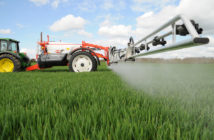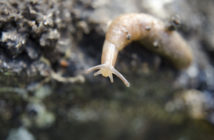Ahead of metaldehyde slug pellet treatments, growers should familiarise themselves with the new Red Tractor Combinable Crops and Sugar Beet and Fresh Produce standards which have been updated to reflect the 2017 enhanced metaldehyde stewardship campaign.
Simon McMunn, spokesman for the Metaldehyde Stewardship Group (MSG), explains why the enhanced stewardship campaign has been implemented.
“Metaldehyde products are undergoing re-registration and the regulatory risk assessment, which forms part of this process, has revealed a requirement for increased protection of birds and small mammals,” says Simon.
“This why the enhanced stewardship has been introduced. However, it’s important to note that water stewardship remains vital and is very much at the forefront of the campaign,” he adds.
“Further to this, stewardship is now a CRD-agreed condition of metaldehyde product availability and regulators will be monitoring the campaign success closely.
“This means it’s more important than ever for the industry to pull together and follow stewardship advice, to help preserve the future of the active ingredient, which remains a key tool in slug control.”
In line with the enhanced stewardship campaign, Red Tractor has introduced a new standard, which will come into force on 1 October 2017.
“In order to reduce the risk to water, birds and small mammals, we have strengthened the Combinable Crops and Sugar Beet and Fresh Produce standards to encourage responsible metaldehyde use,” says Laurence Matthews, Red Tractor combinable crops chair.
“For our members, this means demonstrating appropriate use to avoid run-off and being aware of permitted dose and application rates, as well keeping application records,” he adds.
Aside from the changes to Red Tractor standards, Simon highlights that there is a new metaldehyde stewardship guideline for 2017.
“The new guideline states that no pellets should be allowed to within a minimum of 10 metres of any field boundary or watercourse,” says Simon.
“The buffer was previously six metres and it only applied to watercourses. However, increasing it to 10 metres of all field boundaries will help protect birds and small mammals, and provide additional protection to water,” he adds.
“In addition the new guidelines, we’re also promoting the role of Integrated Pest Management (IPM) in slug control with the view of helping to minimise slug infestation and reduce the need for treatment.
“Factors such as soil and stubble management, planting methods, weather, trapping and monitoring should all be considered as part of slug control programmes. And, if treatment is necessary, it’s imperative to refer to the full set of MSG guidelines.”
The MSG has launched a practical guide on IPM and slug control and you can request copies by emailing info@getpelletwise.co.uk.
Two BASIS points have been allocated to the guide and to claim points, members of the professional register have to read the guide and complete a short series of questions online: www.surveymonkey.co.uk/r/MSG-BASIS
More information on the enhanced MSG stewardship can be found at www.getpelletwise.co.uk




